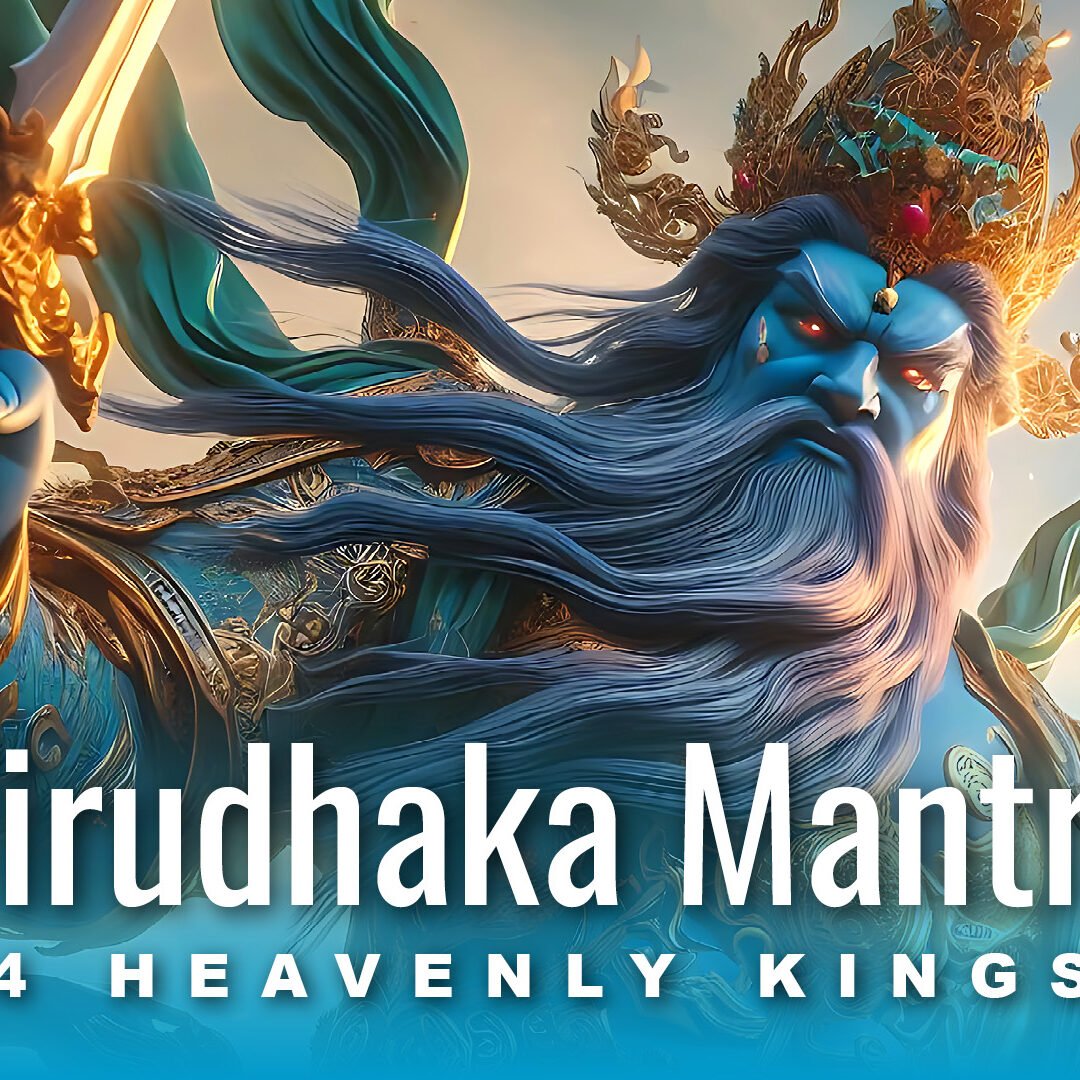Video: Five Buddhist Wisdom Dakinis: Dharma Activities including Chod, with Mantras sung by Yoko Dharma – 49 languages subtitled
Five Wisdom Dakinis: awareness dances into elemental form, wisdom of the Five Buddhas, empowering Chod and Dharma activity
Play video (subtitles and languages enabled):
What are the five Wisdom Dakinis? Why are they central to Tibetan Buddhist practice? Why are they associated with activity practices— peaceful, increasing, magnetizing, subjugating and supreme activities — such as Chod? In this presentation, we try to answer these questions. We present the mantras of the Five Wisdom Dakinis, sung by the amazing Yoko Dharma at the end of this introduction.
The great Padmasambhava, quoted from the book Dakini Activity, defines the vital role of the wisdom Dakini best:
“The source of activity is the dakini and there are five kinds of activities, peaceful, increasing, magnetizing, subjugating, and the supreme activity. The primary way to perfect these is through dakini practices, and among dakinis, there are the wisdom dakinis, in space and worldly. These vast collections of practices can be condensed into those of the three roots, lama, yidam, and dakini.
“The source of blessings is the lama, the source of accomplishment is the yidam, and the source of activities is the dakinis. The one who carries out the activities for the lama and the yidam is the dakini, in other words, the virtue of blessings and accomplishment is the activity, which is the dakini.”
To help clarify how the great Padmasambhava’s words reflect the five Wisdom Dakinis, it can be helpful to clarify both the meaning of Dakini and the symbolism of color and image in Tibetan Buddhism.
Summarizing the Five Great Wisdom Dakinis
The five wisdom Dakinis are the “wisdom” counterparts of the Five Dhyani Buddhas. Dakinis symbolize wisdom activities and Dhyani Buddhas symbolize compassion and method. As the Enlightened Path includes both wisdom and compassion, these are inseparable — which is why the metaphor used is “consort.” Whether wisdom is the consort of compassion, or the reverse, is not important. They are co-equal partners.
Generally, Wisdom activities are carried out by the Wisdom Dakinis. And, this is where the five activities represented by five dakinis become important. Each of these is represented by a color.
Four Activities and the Supreme
In general, there are four activities — plus, the supreme activity. The four activities are peaceful, increasing, magnetizing, and subjugating, and the fifth is the supreme — which is the ultimate combination of all of these.
These are represented by the five colors: white for peaceful activities, yellow for increasing activities, red for magnetizing activities, blue for subjugating. The fifth is green, which is considered to be the combination of all the other four — the supreme. This is why Green Tara and Vajra Dakini are considered to be the “ultimate action heroes” — since they combine all the types of activities in one magnificent Dakini aspect.
White activity — Buddha Dakini
As you might expect, white represents “peaceful activities” such as meditation. As a Dakini, this would be Buddha Dakini, the white Dakini of the center. You might also think of white Vajrasattva, and any meditative, peaceful practice including White Tara, Vairochana Buddha and other white aspects of Enlightenment. Since most Buddhist practices begin with peaceful meditation, the white Dakini is normally in the center of the mandala of the Dakinis, in the form of Buddha Dakini, representing Wisdom that overcomes ignorance. This is because the meditator identifies with being in the center.
Yellow activity — Ratna Dakini
Intuitively, we recognize the warmth of gold or yellow represents increasing. In Buddhist practice, these are activities that help us draw in all auspicious circumstances. In the Dakini mandala, this is Ratna Dakini in the south. Yellow as a symbol connotes the warmth of growth and sunlight and the nurturing sun. Yellow activity symbolizes any increasing activity — which can include increasing wealth, health, knowledge, or any meritorious growth activity.
Red Activity — Padma Dakini
The more passionate “red” color represents magnetizing activities and the seductive power of beauty and skillful means. The red Dakini of Amitabha’s Lotus Family is Padma Dakini. Why is this described as magnetizing? Padma Dakini is alluring and attractive — drawing us in. She uses the skillful means of beauty and attraction to bring us into the Dharma.
Blue Activity — Vajra Dakini
Blue Dakinis and deities are about subjugating and suppressing — subjugating any anger or illness or any negativity. For example, the famous Blue Medicine Buddha is about suppressing disease and ill-health. Wrathful Black Manjushri is an even more wrathful activity of suppressive healing. Blue Dakini, in the east, is the activity of suppressing any negativity.
Green Activity — Karma Dakini
Why is Green or Karma Dakini the supreme activity dakini? Dakinis themselves represent activity. The ultimate form of this is the dakini who combines all colors. In Tibetan symbolism, this is green. This is not only because of color mixing, but because green is the color of nature and all wholesome activities. For most of us, when we think of green, we think of Green Tara, the ultimate action hero, who is none other than Karma Dakini. Karma Dakini is in the north.
Wisdom Dakinis Dance on the Perfection of Sunyata
Wisdom Dakinis are fully Enlightened. Pema Khandro Rinpoche, explains,
“The notion of Dakini in the Great Perfection (Dzogchen) goes hand in hand with the teachings of the five elements and the five wisdoms. Each of these are represented by a variety of enlightened female figures, known as Dakinis, the Five Wisdom Dakinis.”
At the end of this presentation, don’t miss the amazing Yoko Dharma singing the five Dakini Mantras with Venerable Zasep Rinpoche chanting the Heart Sutra.
Five Great Mother Dakinis — One with Prajnaparamita
The Five Wisdom Dakinis are also called the Five Great Mother Dakinis, particularly when associated with Chod practices, which normally focus on Prajnaparamita and the Five glorious Great Mother Dakinis.
It would be a mistake to think of these as “individuals” — rather than aspects. In the Chod Sadhana, the visualization describes the main focus as[3]:
“the Great Mother Mahamata Prajnaparamita and the Five Dakinis, who are all one…”
Likewise, Tara, Vajrayogini is an aspect of Great Mother (Mahamata) Prajnaparamita, as is Machig Labdron. Her mantra, therefore the mantra of the Five Great Mothers, is:
Om Gate Gate Paragate Parasamghate Bodhi Svaha
Om Gahtay Gahtay Paragahtay Parasamgahtay Bodhi Svaha
Summary of the Five Great Wisdom Dakinis
When the Sarva Buddha Dakini (Vajrayogini) emanates elementally, or in the context of focusing on specific poisons, She emanates as the Five Wisdom Dakinis. Likewise, when Vajradhara — the tantra aspect of Shakyamuni Buddha (or, Samantabadhra Buddha in some traditions) — emanates they first emanate as the five Dhayni Buddhas.
The Five Wisdom Dakinis, can be quickly summarized as:
Buddha Dakini Akashadhatvishvari, the Wisdom Dakini of Universal Law — usually in the center, wisdom awareness, Dakini consort of Vairocana’s Buddha, white in color, the element of space or ether. (In some traditions, the center and east positions of both the Dakinis and the Dhyani Buddhas is switched. Alternately, for specific Yidam practices, the Yidam may move to the center of the mandala. For example in Vajrayogini practice, she may move to the center for Her practice, depending on the specific lineage teachings.)
Her short essence mantra, sung by Yoko Dharma at the end of this documentary, is
Om Ah Buddha Dakini Hum Hum Pey Soha
In the east of the Mandala of Wisdom Dakinis appears Vajra-Dakini. She is the Wisdom Dakini — she of Mirror-Like Wisdom. She is the wisdom awareness Dakini consort of Akshobya Buddha and is blue in color, and represents the element of water. Her mantra is:
Om Ah Vajra Dakini Hum Hum Pey Soha
In the south of the Mandala of Wisdom Dakinis appears Ratna-Dakini. She is the Dakini of the Wisdom of Equality — and is the Dakini consort of Ratnasambhava Buddha. She is yellow in color and of the element of earth. Her mantra is:
Om Ah Ratna Dakini Hum Hum Pey Svaha
In the west of the Mandala of Wisdom Dakinis appears Padma Dakini. She is the Dakini of the Wisdom of Discernment and is the Dakini consort of Amitabha. She is red in color and of the element of fire. Her mantra is:
Om Ah Padma Dakini Hum Hum Pey Svaha
In the north of the Mandala of Wisdom Dakinis appears Karma Dakini, the Wisdom Dakini of Activity and Accomplishment. She is the Dakini consort of Amoghasiddhi and is green in color. Her element is the fierce and fast activity of air or wind. Her mantra is:
Om Ah Karma Dakini Hum Hum Pey Svaha
NOTES
[1] Dakini Activity: The Dynamic Play of Awakening, by Padmsambhava, the Lotus Born. On Amazon — https://amzn.to/3nCSwVo (affiliate link.)
- Publisher : Rangjung Yeshe Publications (Sept. 27 2018)
- Language : English · Paperback : 194 pages · ISBN-10 : 0997716274 · ISBN-13 : 978-0997716276
More articles by this author
Search
Latest Features
Please support the "Spread the Dharma" mission as one of our heroic Dharma Supporting Members, or with a one-time donation.
Please Help Support the “Spread the Dharma” Mission!

Be a part of the noble mission as a supporting member or a patron, or a volunteer contributor of content.
The power of Dharma to help sentient beings, in part, lies in ensuring access to Buddha’s precious Dharma — the mission of Buddha Weekly. We can’t do it without you!
A non-profit association since 2007, Buddha Weekly published many feature articles, videos, and, podcasts. Please consider supporting the mission to preserve and “Spread the Dharma." Your support as either a patron or a supporting member helps defray the high costs of producing quality Dharma content. Thank you! Learn more here, or become one of our super karma heroes on Patreon.
Lee Kane
Author | Buddha Weekly
Lee Kane is the editor of Buddha Weekly, since 2007. His main focuses as a writer are mindfulness techniques, meditation, Dharma and Sutra commentaries, Buddhist practices, international perspectives and traditions, Vajrayana, Mahayana, Zen. He also covers various events.
Lee also contributes as a writer to various other online magazines and blogs.


















